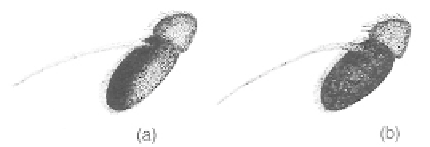Agriculture Reference
In-Depth Information
ence in mushroom houses, therefore, is an indi-
cation of unsuitable growing conditions. Al-
though the larvae are saprophytic and entirely
harmless, the adult flies may inadvertently trans-
fer harmful organisms to healthy mushroom
beds. The small, black-bodied adults are often
mistaken for scuttle flies (especially as they
scurry over the compost surface in a phorid-like
manner, see p. 177) but are readily distinguished
by the presence of cross-veins in the wings, by
other details of the wing venation and by their
very short, swollen hind metatarsi.
(a) (b)
Fig. 253
Antennae of psilid flies: (a)
Psila rosae;
(b)
P. nigricornis.
tooth;
posterior spiracles
distinctly pigmented
and 3-pored (cf.
Napomyza carotae,
p. 189).
Puparium
5-7 mm long; elongate, yellowish-
brown.
Family OPOMYZIDAE
Geomyza tripunctata
Fallen
Grass & cereal fly
Psila nigricornis
Meigen
larva =
Chrysanthemum stool miner
This widely distributed fly is associated mainly
with rye-grass and certain other grasses but will
also attack wheat. The larvae feed within the
central shoots that then turn yellow and die
('dead-heart' symptom). Infestations, however,
do not reach economic levels.
This insect is associated with chrysanthemum
stools and was formerly an important pest.
Nowadays, however, owing to changes in cul-
tural techniques and better hygiene procedures,
infestations are infrequent. Chrysanthemum
cuttings and lettuces planted in infested chrysan-
themum stool beds are also attacked. Adults are
normally active in May and June. Eggs are then
deposited in the soil close to chrysanthemum
plants. The eggs hatch about 2 weeks later. The
creamish-white, shiny larvae mine within the
stools to form long, but superficial, galleries. Pu-
pation takes place in the soil 1-2 months later,
and a second generation of adults appears in the
late summer or autumn. Second-generation lar-
vae feed throughout the winter and, under glass-
house conditions, usually give rise to adults by
March. Adult flies are bluish-black, with the
head and legs brownish-yellow and the bulbous
third antennal segment mainly black
(Fig. 253b)
(cf.
Psila rosae,
p. 181).
BIOLOGY
Adults occur at any time from early March to
November, but are usually most numerous in
April and again from July to October. Eggs are
deposited singly on the stems of host plants, usu-
ally at or just below soil level. After egg hatch,
the larva bores into the base of a leaf and then
burrows spirally downwards to enter the base of
the central shoot, within which further develop-
ment takes place. Larvae eventually pupate in
the soil and adults emerge 17-30 days later.
There are normally two generations annually.
The winter is usually passed in the final (third)
larval instar, such individuals then pupating in
February or March.
Family SPHAEROCERIDAE
(lesser dung flies)
Pullimosina heteroneura
(Haliday)
DESCRIPTION
Adult
2.5-3.5 mm long, greyish-black.
Egg
lmm long, spindle-shaped, shiny white, with
numerous irregular longitudinal furrows and
ridges.
Larva
up to 6.5 mm long;
body
plump,
greyish-white and opaque
(Plate 7c);
anterior
spiracles
elongate, each with up to 16 lobes;
This common fly breeds in manure and may also
occur in poor mushroom-house compost where
bacterial decomposition is underway. Its pres-

